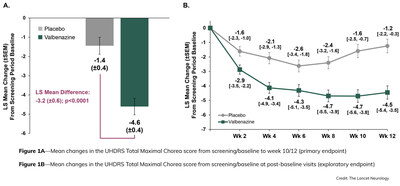Neurocrine Biosciences Announces Publication of Full KINECT™-HD Phase 3 Study Results of Valbenazine for the Treatment of Chorea Associated with Huntington's Disease in The Lancet Neurology
- The Phase 3 study showed statistically significant improvement in chorea severity and global impression of change
- Valbenazine demonstrated a reduction in chorea symptoms and improvement in overall chorea severity
- Improvement in chorea symptoms was seen as early as Week 2
- 82% of valbenazine-treated participants were taking 80 mg by the end of the study
- Secondary endpoints of CGI-C and PGI-C response status were also statistically significant
- Treatment-emergent adverse events were mild to moderate and consistent with the known safety profile of valbenazine
- The study implemented the Huntington's Disease Health Index (HD-HI), showing improvement in mobility and hand/arm function
- No statistical difference between treatment groups in the secondary Quality of Life endpoints
- No suicidal behavior or worsening of suicidal ideation was observed in the valbenazine-treated subjects
- Statistically Significant Improvement in Chorea Associated with
- Chorea Improvement Supported by Statistically Significant Clinical Global Impression of Change (CGI-C) Response Status and Patient Global Impression of Change (PGI-C) Response Status Scores at Week 12
- First Phase 3 Study to Implement Huntington's Disease Health Index (HD-HI), a Patient-Reported Outcome Measure, Showed Reduced Disease Burden as Reported by Patients Receiving Valbenazine versus Placebo
- Supplemental New Drug Application (sNDA) Filed, with Prescription Drug User Fee Act (PDUFA) Target Date Set for August 20, 2023
"We're pleased to share the KINECT-HD full study results with the scientific community and its acceptance in an esteemed journal following rigorous peer-review," said Eiry W. Roberts, M.D., Chief Medical Officer at Neurocrine Biosciences. "There remains a need for symptomatic treatments for chorea associated with
Valbenazine is a novel vesicular monoamine transporter 2 (VMAT2) inhibitor. VMAT2 inhibitors have been shown to reduce chorea associated with HD.
"More than 90 percent of adults with HD experience chorea," said Erin Furr Stimming, M.D., the paper's lead author and professor in the Department of Neurology and Memorial Hermann Chair with McGovern Medical School at UTHealth Houston. "The KINECT-HD study data demonstrated statistically significant improvement in chorea associated with HD as compared with placebo. The safety profile for participants with chorea associated with HD was consistent with the known safety profile of valbenazine. By the end of the 12-week study, 82 percent of valbenazine-treated participants were taking 80 mg."
The KINECT-HD randomized double-blind, placebo-controlled Phase 3 study was conducted with 128 participants at 46 Huntington Study Group (HSG)–credentialed sites in
The primary endpoint was a reduction in severity of chorea, the cardinal motor feature in HD, as measured by change in the Unified Huntington's Disease Rating Scale (UHDRS®) Total Maximal Chorea (TMC) score from baseline to the average score at weeks 10 and 12. The TMC score is part of the motor assessment of the UHDRS that measures chorea.
In the KINECT-HD study, treatment with valbenazine resulted in a placebo-adjusted mean reduction in the TMC score of 3.2 units (P < 0.0001), indicating a highly statistically significant improvement in chorea (Figure 1A). Improvement was seen at Week 2 as participants completed the lowest study dose (40 mg), with consistently greater improvement relative to placebo in all subsequent visits (Weeks 4 to 12), as the dose was adjusted from 40 mg to 60 mg and 80 mg over the course of the 12-week study (Figure 1B).
Secondary endpoints of Clinical Global Impression of Change (CGI-C) response status and Patient Global Impression of Change (PGI-C) response status were also statistically significant and supported the improvements in TMC score that were seen over the 12-week study period. At Week 12, more participants were classified as "much improved" or "very much improved" according to these key secondary endpoints when treated with valbenazine than placebo (CGI-C: 43 percent versus 13 percent; PGI-C: 53 percent versus 26 percent). No statistical difference between treatment groups was found in either of the two secondary Quality of Life in Neurological Disorders (Neuro-QoL) endpoints.
Treatment-emergent adverse events, including somnolence, fatigue, fall and akathisia, were mild to moderate and consistent with the known safety profile of valbenazine. No suicidal behavior or worsening of suicidal ideation was observed in the valbenazine-treated subjects in this study.
The KINECT-HD study marked the first-ever implementation of the
The
HD is a hereditary, progressive, and ultimately fatal neurodegenerative disorder in which the loss of certain neurons within the brain causes motor, cognitive and psychiatric symptoms. More than nine out of 10 people with HD will experience chorea, an involuntary movement disorder, at some point in the course of their disease. HD chorea has been shown to significantly impact physical, social and emotional function among those living with HD.
About the KINECT™-HD Study
KINECT-HD is a Phase 3, randomized, double-blind, placebo-controlled study designed to evaluate the efficacy of valbenazine as a once-daily treatment to reduce chorea associated with Huntington's disease (HD) and evaluate the safety and tolerability of valbenazine in patients with HD. The study enrolled 128 adults 18 to 75 years of age who have been diagnosed with manifest HD and who have sufficient chorea symptoms to meet study protocol criteria.
Top-line clinical data from the KINECT-HD study were reported in December 2021 and demonstrated that adults with chorea associated with HD had a significantly greater improvement in the Unified Huntington's Disease Rating Scale (UHDRS®) Total Maximal Chorea (TMC) score when treated with valbenazine versus placebo (least squares mean difference of -3.2; 95 percent confidence interval, -4.4 to -2.0; P < 0.0001). The secondary endpoints included Clinical Global Impression of Change (CGI-C) response status and Patient Global Impression of Change (PGI-C) response status for valbenazine treatment. The treatment-emergent adverse events in this study were consistent with the known safety profile of valbenazine. No suicidal behavior or worsening of suicidal ideation were observed in the valbenazine-treated subjects in this study.
KINECT-HD and KINECT-HD2 clinical study data were included in the supplemental new drug application (sNDA), which was accepted by the
For more information on this KINECT-HD study, please visit www.huntingtonstudygroup.org.
About KINECT™-HD2
KINECT-HD2 is an open-label study to evaluate the long-term safety and tolerability of valbenazine in patients with chorea associated with Huntington's disease (HD). The 156-week study will enroll up to 150 adults 18 to 75 years of age who have been diagnosed with motor-manifest HD and who have sufficient chorea symptoms to meet study protocol criteria. For more information on the KINECT-HD2 study, please visit www.huntingtonstudygroup.org or ClinicalTrials.gov.
About
The
About Chorea Associated with Huntington's Disease (HD)
About Huntington Study Group / HSG Clinical Research, Inc.
The Huntington Study Group (HSG), a not-for-profit organization founded in 1993 in
The KINECT-HD study was conducted in cooperation with the HSG and the Clinical Trials Coordination Center (CTCC) at the University of Rochester Medical Center's Center for Health + Technology (CHeT). For more information, visit the CTCC website https://www.urmc.rochester.edu/health-technology/our-expertise/clinical-trials-coordination.aspx.
About Neurocrine Biosciences, Inc.
Neurocrine Biosciences is a leading neuroscience-focused, biopharmaceutical company with a simple purpose: to relieve suffering for people with great needs, but few options. We are dedicated to discovering and developing life-changing treatments for patients with under-addressed neurological, neuroendocrine, and neuropsychiatric disorders. The company's diverse portfolio includes FDA-approved treatments for tardive dyskinesia, Parkinson's disease, endometriosis* and uterine fibroids*, as well as a robust pipeline including multiple compounds in mid- to late-phase clinical development across our core therapeutic areas. For three decades, we have applied our unique insight into neuroscience and the interconnections between brain and body systems to treat complex conditions. We relentlessly pursue medicines to ease the burden of debilitating diseases and disorders, because you deserve brave science. For more information, visit neurocrine.com, and follow the company on LinkedIn, Twitter and Facebook. (*in collaboration with AbbVie)
Neurocrine and the Neurocrine logo are registered trademarks, and KINECT is a trademark of Neurocrine Biosciences, Inc.
Neurocrine Biosciences Forward-Looking Statements
In addition to historical facts, this press release contains forward-looking statements that involve a number of risks and uncertainties. These statements include, but are not limited to, statements regarding the potential benefits to be derived from the Company's products and product candidates. Among the factors that could cause actual results to differ materially from those indicated in the forward-looking statements include: risks that valbenazine may not obtain regulatory approval for chorea in
![]() View original content to download multimedia:https://www.prnewswire.com/news-releases/neurocrine-biosciences-announces-publication-of-full-kinect-hd-phase-3-study-results-of-valbenazine-for-the-treatment-of-chorea-associated-with-huntingtons-disease-in-the-lancet-neurology-301828576.html
View original content to download multimedia:https://www.prnewswire.com/news-releases/neurocrine-biosciences-announces-publication-of-full-kinect-hd-phase-3-study-results-of-valbenazine-for-the-treatment-of-chorea-associated-with-huntingtons-disease-in-the-lancet-neurology-301828576.html
SOURCE Neurocrine Biosciences, Inc.
FAQ
What were the results of the Phase 3 study of valbenazine for the treatment of chorea associated with Huntington's disease?
When was improvement in chorea symptoms seen?
What dose of valbenazine were participants taking by the end of the study?
What were the results of the secondary endpoints?
What were the treatment-emergent adverse events observed?









